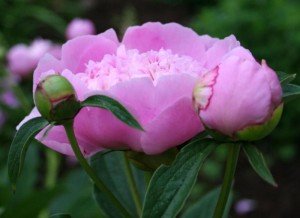It may be only months, but it feels like an eternity ’til we see the peonies bloom again.
That’s a sad thought for many, but the good news is that we can use the nice weekend ahead to get perennials off to a good start in next year’s growing season.
Fall is one of the best times to plant new and divide existing perennials – peonies, daylilies, Echinacea and all the rest. Soil conditions in the fall are usually better for digging than in the spring. Now, there’s no dodging the frequent late-season snows and the muddy conditions they produce.
Fall planting also gets the  plants feeling at home in their new digs so the roots take hold and start growing. By springtime, the plants will be better established and may offer up more first-season blooms than if you wait until spring to plant them.
plants feeling at home in their new digs so the roots take hold and start growing. By springtime, the plants will be better established and may offer up more first-season blooms than if you wait until spring to plant them.
Here are some tips to for giving perennials a head start on the next growing season.
Divide and conquer
If you have perennials that have been in place 4-6 years or are overgrowing their space, separate them with a shove into two or more plants. This process rejuvenates the plants and also yields more plants to enjoy in other areas of your yard. All perennials benefit from this process and especially, ornamental grasses that sometimes appear to die out in the center.
Clean up the soil
Make sure the bed area where you add new or divided plants has been cleaned up of weed debris. Remove perennial weed roots, encroaching turf grass and old debris that may have seeds. The cleaner the bed, the fewer weed issues you will have next season.
Amend the soil
- If you are planting an entire bed of perennials, prep the entire area with organic matter such as compost, well-rotted manure or peat moss that is at least 6 inches deep.
- Dig holes that are 2-3 times the size of the root ball of the plant and plant with amended soil. The organic matter helps roots to become established and grow.
- Group plants according to their water needs to avoid over-watering some and under-watering others.
Post planting steps
- Water plants after planting – and be prepared to check soil moisture throughout the fall and winter. Even though plants are dormant, they can still dry out and require water.
- Mulch around plants with an organic mulch such as shredded bark. This will help moderate the soil temperature and retain moisture throughout the winter.
- Fertilize with a root-developing fertilizer. Next spring, you’ll enjoy the results of these late-seasoning gardening chores. Our plants always make us glad we made the effort.
Designscapes Colorado is the leader in landscape design and maintenance. We strive to provide only the highest quality landscaping across all of Colorado. We understand your need for a beautiful looking landscape. Beauty and perfection is ingrained in our roots and is a part of our core of what we believe in. For your next landscaping project, give us a call or send us an email at: info@designscapes.org. We can make your imagination become a reality!
